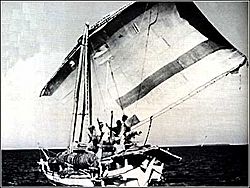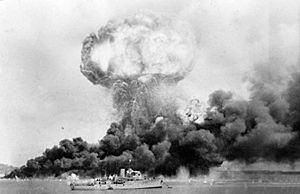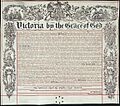History of the Northern Territory facts for kids
The history of the Northern Territory began over 60,000 years ago. This is when Indigenous Australians first settled the region. Later, traders from Makassar (in what is now Indonesia) began trading with Indigenous people. They traded for a sea creature called trepang, which was important for food and medicine. This trade started at least by the 1700s.
Europeans first saw the coast of the Northern Territory in the 1600s. British groups tried to settle the coastal areas from 1824 onwards. However, none of these early settlements lasted. The first successful settlement was Port Darwin in 1869.
Contents
Ancient Times
The Northern Territory has some of the oldest evidence of people living in Australia. Archaeologists have found signs of settlement from about 60,000 years ago. This was a time when sea levels were much lower than today. Australia and New Guinea were connected as one large landmass.
The original inhabitants of the Northern Territory created amazing rock art. This art shows their rich culture and spiritual beliefs. It is hard to date rock art exactly. However, experts have found three main periods of art. These show changes in climate, animals, and technology over time. For example, the art shows how tools like boomerangs and spearthrowers changed. Later art even shows things like Makassan trading boats and European guns.
The dingo is a type of wild dog. It arrived in Australia from Asia about 3,500 years ago. Dingoes quickly became part of Aboriginal life. They helped with hunting and even kept people warm on cold nights.
Makassan and Baijini Trade
Sailors from islands north of Australia traded with northern Australia long ago. This was even before the Dutch arrived in Indonesia around 1600 AD. First, the Baijini people came to trade for pearls and shells. They sometimes brought their families and built temporary homes. They even tried planting rice in some areas.
Later, people from Makassar came looking for trepang. Trepang was valuable in Chinese markets for food and medicine. The Makassan traders only came to collect trepang. They did not set up permanent farms, though some tamarind seeds they dropped grew into trees. These yearly Makassan trips to the Kimberleys and Arnhem Land started in the 1700s. They stopped in 1907 because of new Australian rules. However, some reports suggest visits might have happened 300 years earlier. The Makassans had a lot of contact with Indigenous tribes. They traded cloth, knives, alcohol, and tobacco. In return, they could fish in Territory waters and use Aboriginal workers.
European Exploration and Settlement
The first European to record seeing the Northern Territory coast was Willem Janszoon from the Netherlands in 1606. Other explorers like Abel Tasman and French navigators also mapped the coast. Captain Phillip Parker King later surveyed the coast too.
After the British settled in New South Wales in 1788, they tried to settle the Northern Territory coast four times. All these attempts failed before Darwin was finally established.
Early Attempts (1824–1838)
On 30 September 1824, British Captain James Bremer set up Fort Dundas on Melville Island. This was the first British settlement in Northern Australia. But there were problems with the local Tiwi people, cyclones, and the hot climate. So, the fort was left empty in 1828.
A second settlement, Fort Wellington, was started on the Cobourg Peninsula in 1827. Captain James Stirling founded it. But it was also abandoned in 1829.
More Attempts (1838–1861)
The British tried a third time in 1838. They built Fort Victoria at Port Essington. James Bremer was again in charge. The famous ship HMS Beagle visited in 1839. After Bremer left, conditions got worse. The settlement was finally abandoned on 1 December 1849.
During this time, European explorers made many difficult journeys into Australia's inland. They wanted to find new lands for farming or answer scientific questions. Explorers like Ludwig Leichhardt tried to map unknown areas.
New Discoveries (1862–1868)
In 1862, John McDouall Stuart successfully crossed Central Australia from south to north. His journey mapped the path for the future Australian Overland Telegraph Line. Stuart wanted to name the new region "Alexandra Land." This name was used for the southern part of what is now the Northern Territory for a while.
In 1863, the Northern Territory became part of South Australia. After this, a fourth settlement attempt happened in 1864 at Escape Cliffs. This was about 75 km from present-day Darwin. Colonel Boyle Travers Finniss was in charge. There were many conflicts with the local Marananggu people. When Finniss was called back in 1867, the settlement was closed.
Darwin is Founded (1869–1900)
On 5 February 1869, George Goyder, from South Australia, started a small settlement at Port Darwin. Goyder named it Palmerston, after the British Prime Minister Lord Palmerston. In 1870, the first poles for the Overland Telegraph were put up in Darwin. This telegraph line would connect Australia to the rest of the world.
Uluru and Kata Tjuta were first mapped by Europeans in 1872. This was possible because of the Overland Telegraph Line. Ernest Giles and William Gosse were the first European explorers to the area. In 1872, Giles saw Kata Tjuta and named it Mount Olga. The next year, Gosse saw Uluru and named it Ayers Rock. At first, Europeans thought these desert lands were not good for farming. But later, they became famous symbols of Australia.
The building of the Overland Telegraph led to more exploration. Gold was discovered at Pine Creek in the 1880s. This helped the Territory grow even more.
20th Century
On 1 January 1911, the Northern Territory was separated from South Australia. It came under the control of the Australian government. An Administrator was appointed to manage the Territory.
For a short time between 1926 and 1931, the Northern Territory was split into two parts: North Australia and Central Australia. Later, a plan called the Kimberley Scheme looked at parts of the Northern Territory as a possible place for a Jewish Homeland. However, it was not chosen.
Central Australia
Between 1918 and 1921, large areas of the Territory became Aboriginal reserves. These were places for nomadic Aboriginal groups who had little contact with Europeans. In 1920, the area around Uluru was declared an Aboriginal Reserve. Even so, some non-Aboriginal people still visited, like missionaries and gold prospectors. In 1940, the reserve was made smaller to allow for gold prospecting.
Tourists started visiting Uluru in 1936. A road for cars was built in 1948. After World War II, government policies aimed to help Aboriginal people join Australian society. Many were moved to Aboriginal settlements.
Caledon Bay Crisis
The Caledon Bay crisis happened between 1932 and 1934. It was one of the last times there was violent conflict between Indigenous and non-Indigenous Australians. As the crisis unfolded, many Australians supported the Aboriginal people involved. An important legal appeal was made to the High Court of Australia on behalf of an Indigenous Australian. After the crisis, an anthropologist named Donald Thomson lived among the Yolngu people to understand their culture.
World War Two
Australia declared war on Nazi Germany in 1939. When Japan entered the war in 1941, the Northern Territory came under direct attack. Most of Australia's best soldiers were fighting in the Middle East. Japan attacked Pearl Harbor in Hawaii. Then, on 19 February 1942, Darwin suffered a terrible air raid. Over the next 19 months, Australia was attacked from the air almost 100 times.
Aboriginal Land Rights
Indigenous Australians fought for fair wages and land rights for a long time. A very important event was the strike and walk off by the Gurindji people at Wave Hill cattle station in 1966. The Australian government then set up the Woodward Royal Commission in 1973. This commission looked into how land rights could be given in the Northern Territory.
The Aboriginal Land Rights (Northern Territory) Act 1976 was finally passed on 16 December 1976. It began on Australia Day, 26 January 1977. This law was a big step in recognizing Aboriginal land ownership.
Self-Government
In 1978, the Northern Territory was granted self-government. This meant it had its own Legislative Assembly and a Chief Minister. The Country Liberal Party (CLP) was very successful in elections from 1974 until 2001. In 2001, the Australian Labor Party won. Clare Martin became the first Labor Party Chief Minister and the first female Chief Minister. Later, Marion Scrymgour became the Deputy Chief Minister. She was the highest-ranked Indigenous person in government in Australia's history at that time. She was also the first Indigenous woman elected to the Northern Territory Parliament.
See also
- History of Darwin
- Timeline of Darwin history
Images for kids
-
An Arrernte man in a traditional hut in 1920.







